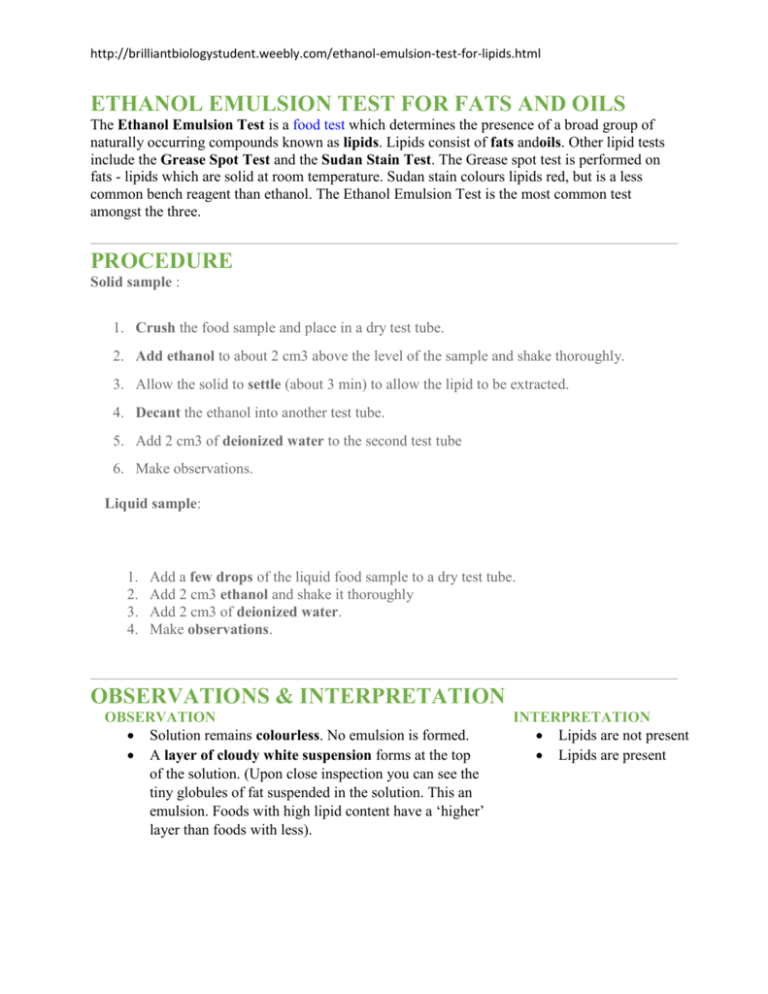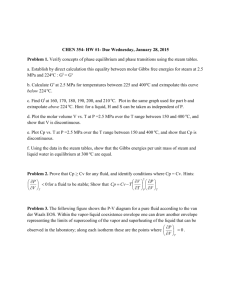ethanol emulsion test for fats and oils
advertisement

http://brilliantbiologystudent.weebly.com/ethanol-emulsion-test-for-lipids.html ETHANOL EMULSION TEST FOR FATS AND OILS The Ethanol Emulsion Test is a food test which determines the presence of a broad group of naturally occurring compounds known as lipids. Lipids consist of fats andoils. Other lipid tests include the Grease Spot Test and the Sudan Stain Test. The Grease spot test is performed on fats - lipids which are solid at room temperature. Sudan stain colours lipids red, but is a less common bench reagent than ethanol. The Ethanol Emulsion Test is the most common test amongst the three. PROCEDURE Solid sample : 1. Crush the food sample and place in a dry test tube. 2. Add ethanol to about 2 cm3 above the level of the sample and shake thoroughly. 3. Allow the solid to settle (about 3 min) to allow the lipid to be extracted. 4. Decant the ethanol into another test tube. 5. Add 2 cm3 of deionized water to the second test tube 6. Make observations. Liquid sample: 1. 2. 3. 4. Add a few drops of the liquid food sample to a dry test tube. Add 2 cm3 ethanol and shake it thoroughly Add 2 cm3 of deionized water. Make observations. OBSERVATIONS & INTERPRETATION OBSERVATION Solution remains colourless. No emulsion is formed. A layer of cloudy white suspension forms at the top of the solution. (Upon close inspection you can see the tiny globules of fat suspended in the solution. This an emulsion. Foods with high lipid content have a ‘higher’ layer than foods with less). INTERPRETATION Lipids are not present Lipids are present http://brilliantbiologystudent.weebly.com/ethanol-emulsion-test-for-lipids.html PRINCIPLE OF THE ETHANOL EMULSION TEST The solubilities of lipids and ethanol are exploited in this test. Lipids are non-polar organic compounds. Hence they are soluble in organic solvents such as ethanol (alcohol), but insoluble in water. Ethanol is an organic substance and so dissolves other organic substances; it is frequently used as an organic solvent. However ethanol is also miscible in water due to the presence of the hydroxyl (-OH) functional groups and the shortness of its chain (2C). The hydroxyl group participates in hydrogen bonding with water. The hydrophobic interaction of the carbon in the short chain with water is not great and is overcome by the hydrogen bonding. Ethanol extracts the lipid from the crushed solid sample. As ethanol is miscible with lipids no change is seen upon its addition to the solid and liquid samples. The lipid spontaneously comes out of solution when water is added and is dispersed as micelles (small droplets) throughout the solution of ethanol and water.( This happens as hydrophobic portion of the lipid molecules project inwards and excludes the aqueous environment; the hydrophilic portion (-COOH) group faces the aqueous environement.) A layer is formed at the top as lipids are less dense than water. The droplets diffract light, appearing cloudy white. CONCLUSIVE TEST A positive test shows conclusively that lipids are present - and not the other major biological molecules. 1. Carbohydrates http://brilliantbiologystudent.weebly.com/ethanol-emulsion-test-for-lipids.html Reducing sugars and non- reducing sugars - slightly soluble in ethanol and soluble in water Starch – insoluble in both ethanol and water 2. Proteins – insoluble in ethanol (the addition of ethanol is used to precipitate proteins) 3. Nucleic Acids – are insoluble in ethanol and soluble in water. No change is seen in a negative test as there are no lipids to come out of solution.







